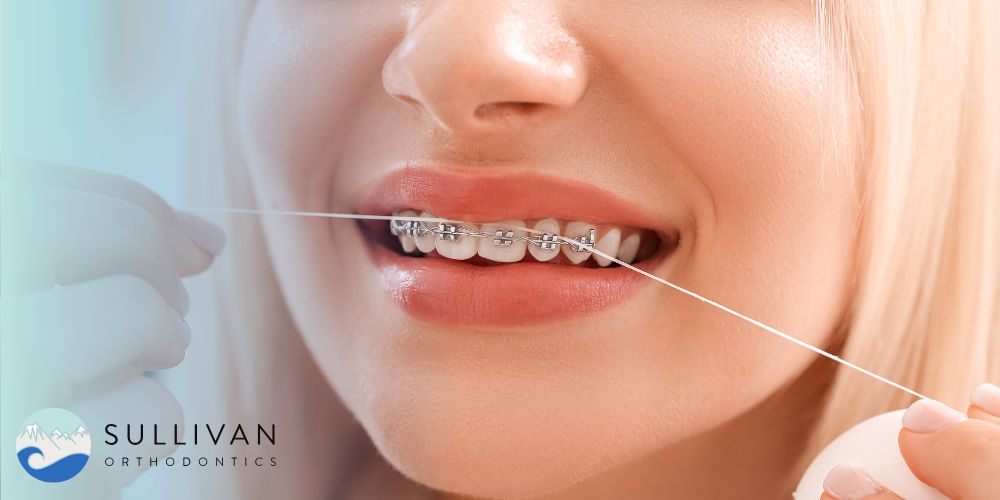Good oral hygiene is crucial when you have braces. The brackets and wires create more spaces where food particles can get trapped, leading to plaque buildup and potential tooth decay. By following specific brushing and flossing techniques, you can keep your teeth clean and avoid these issues.
Maintaining braces also involves being mindful of what you eat and knowing how to handle common problems that might arise. Adjusting to these new habits may take some time, but the results—a beautiful, healthy smile—are worth it. Join us, the best orthodontist in Redmond, as we dive into how you can take care of your braces effectively every day.
Daily Brushing and Flossing Techniques
Keeping your braces clean starts with effective brushing and flossing. You should brush your teeth at least two to three times a day to remove any food particles and plaque. Use a soft-bristle toothbrush and fluoride toothpaste. Angle your toothbrush at 45 degrees from your gums and brush gently but thoroughly.
Make sure to brush each bracket individually. Use tiny circular motions around the brackets and wires. Don’t forget to clean the areas between your braces and gums. You can also use an interdental brush, which is a small brush designed to clean between the braces and teeth.
Flossing with braces might be tricky, but it’s essential. Use a floss threader to get the dental floss under the main wire of your braces. Gently push the floss between your teeth and move it up and down to remove any trapped food. Repeat this for each tooth to keep your mouth clean and healthy. A water flosser is another helpful tool. It uses a stream of water to clean between your teeth and braces, making flossing easier and more effective.
Foods to Avoid with Braces
Being mindful of what you eat is crucial when you have braces. Certain foods can damage your braces or get stuck in them, leading to potential problems. Here’s a list of foods to avoid:
- Hard Foods: These can break or dislodge brackets and wires. Avoid nuts, hard candies, and ice.
- Sticky Foods: Foods like caramel, gum, and chewy candies can stick to your braces and be hard to clean off.
- Crunchy Foods: Corn on the cob, raw carrots, and popcorn can cause damage or get stuck in your braces.
- Sugary Foods and Drinks: Too much sugar can lead to tooth decay. Limit soda, candy, and sweetened beverages.
Instead, opt for braces-friendly foods such as soft fruits, yogurt, cooked vegetables, mashed potatoes, and soft-cooked meats. By being selective about what you eat, you can keep your braces intact and your treatment on track.
Handling Common Braces Issues at Home
Even with the best care, issues with braces can still arise. Knowing how to handle common problems can prevent discomfort and avoid disruption in your orthodontic treatment. Here are some tips for dealing with typical braces issues at home:
- Loose Brackets: If a bracket becomes loose, push it back into position gently. Use orthodontic wax to temporarily hold it in place. Make sure to schedule an appointment to get it fixed.
- Poking Wires: If a wire is poking your cheek or gums, use a clean pencil eraser to push it back into place. You can also cover the end with orthodontic wax to reduce irritation.
- Soreness: After adjustment appointments, your teeth may feel sore. Rinse your mouth with warm salt water to relieve discomfort. Over-the-counter pain relievers like ibuprofen can also help.
- Lost Rubber Bands: If you lose a rubber band, replace it as soon as possible. Always carry some extra bands with you.
Keep these tools handy for emergencies:
- Orthodontic wax
- Pencil eraser
- Spare rubber bands
- Over-the-counter pain relievers
By handling these common issues properly, you can ensure your treatment stays on track.
Scheduling and Preparing for Orthodontic Checkups
Regular checkups are essential for successful orthodontic treatment. Scheduling and preparing for these appointments can help each visit go smoothly. Aim to have a checkup every 4 to 6 weeks.
Here’s how to prepare for your orthodontic checkups:
- Keep a Calendar: Mark your appointment dates in a calendar so you can plan ahead and avoid conflicts.
- Confirm Appointments: Call the office a day before to confirm the appointment and ensure there are no scheduling conflicts.
- Prepare Questions: Write down any questions or concerns you have about your braces to discuss them with your orthodontist.
During the checkup, your orthodontist in Redmond, OR will adjust your braces, check for any issues, and provide advice on care. It’s important to let them know if you’ve had any problems since your last visit.
Follow these tips to make the most of your appointments. Regular visits ensure your treatment progresses as planned and any issues are addressed promptly.
Caring for your braces requires some additional effort, but the rewards are well worth it. By following proper brushing and flossing techniques, you can keep your teeth and braces clean. Avoiding certain foods will help keep your braces intact. Knowing how to handle common issues at home can prevent unnecessary discomfort and ensure your treatment stays on track. Regular orthodontic checkups are essential for monitoring your progress and making necessary adjustments.
If you follow these tips, you can achieve a healthy, beautiful smile. Remember, our team at Sullivan Orthodontics in Redmond is here to support you through your orthodontic journey. If you have any questions or need assistance with your braces, don’t hesitate to contact your local orthodontist in Redmond. Schedule your next appointment with Sullivan Orthodontics today and take the next step toward a confident smile!
